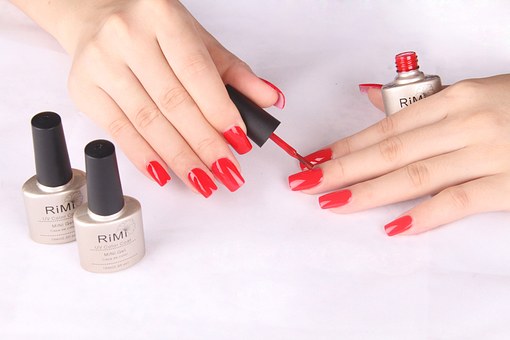How to apply nail polish properly
Trim and file your nails.
Before you begin to paint
your nails, it's important that you create the desired shape of your
nails. Trimming them to the length that you want them and smoothing out
the edges with a nail file will help you achieve a prettier, polished
look, and will prevent your nails from chipping as quickly.
- When you file your nails, make sure to move the nail file in one
direction. You don't want to saw your nails back and forth, as this can
create jagged edges and lead to splitting, breaking, and pealing. Focus
on moving the file from left to right, gently swiping the edge of your
nail as you go across it.
Buff your nails
To achieve a polished look on your nails and remove any ridges in your nails, use a four-way buffer. Make sure to move the buffer in an X pattern, and don't over-buff your nails as this can create too much friction, which will build up heat, resulting in weak nails.
- Make sure when you buff your nails that you lift the buffer between strokes, so that excess friction is not created on your nails.
- A four-way buffer is essentially a buffer block, with four different sides that range from a course surface to a very fine surface. Start by buffing your nails with the coarse surface to shape and define nails, then move to the fine grain surface to smooth and refine nails. Next, use the super fine grain surface to even out the ridges in your nails and finally use the ultra-smooth surface to give nails a glossy shine.
Avoid cutting or trimming your cuticles
When you visit a nail salon, many nail artists will cut your cuticles because it can create a nicer appearance on your nails. Unless you are a trained nail technician, don't mess with your cuticles as you can risk damaging them. Cuticles are there to provide a protective barrier on your nail, so instead of cutting them, try applying a cuticle oil that will moisturize and soften dry cuticles.Clean your nails.
Before you apply your nail polish, it's important that you nails are free of any dirt, moisture, or old nail polish that will cause a new coat of nail polish to chip easier because it won't be able to cling to your nails as well. Wash your hands with soap and water, and consider swiping nails with a cotton ball soaked in nail polish remover to remove any excess oils.
- Make sure that you dry your hands after you clean them to remove any excess moisture on your nails. Nail polish won't go on smoothly if your nails have water droplets on them.
Find the right white
White nail polish couldn't be cooler than it is right now — it's a super-mod, must-wear shade. But when you're choosing a bottle, you want to make sure the formula is thick and creamy, so that it doesn't go on too sheer or streaky. To make sure it's opaque, take the brush and wipe it against the inside of the top of the bottle; if the polish is sheer against the inside of the bottle, it's not pigmented enough.
Stay away from quick-dry nail polish
It's typically dehydrating and can dry out your nails.
Apply a base coat
After you have prepped your nails, you'll want to put a base coat on your nails to make your nail polish last longer and cling better to your nails. Use a base coat that is a good quality, like the nail polish brands listed above, and apply a thin layer with about three swipes of polish. Let the base coat dry before you apply your nail polish. Base coat not only helps the nail polish cling to your nails (it's usually sticky, which helps the nail polish stay on your nails so don't be alarmed) but it also prevents darker colors from staining your nails.
Apply the first layer of nail polish and let it dry
After you have applied a base coat to your nails you can start applying the actual nail polish. Taking your nail polish brush, dip it in the polish just so you have enough polish on your brush to create a thin layer. Then, swipe on the nail polish with three, thin strokes with one in the middle and two on the sides. Let your nail polish dry for two minutes before applying the second coat.
Apply a second layer and let it dry
After your nail polish has dried, you can apply your second layer of polish, using the same technique as the first layer with three, even strokes of polish. Let your polish dry and proceed to the third coat if you want a darker color. If you are going for a lighter color, the second layer can be your last layer.
Apply a top coat
Once you have finished applying the color to your nails, you'll need to apply a top coat to help the nail polish last longer and to keep it from chipping. Make sure your nails are dry before you apply the top coat -- they shouldn't feel sticky. Then, apply a layer of top coat with three swipes in one direction across your nails. Let the top coat dry before you do anything else with your hands to keep your nails from chipping or smudging.
- If you aren't sure if your nails are dry and you don't want to touch them to risk messing up your nail polish, you can swipe a thin layer of top coat across your nail. If the brush on the top coat polish shows any color, then your nail polish isn't dry yet and you need to wait a few more minutes before applying the last coat.
- To help you nails dry faster you can dip them in ice water or very cold running water. Unless you are in a hurry, though, it's best to apply a top coat that works slowly, as it will leave a more protective finish.
Touch up your nails
As you were painting your nails you might have noticed that you were getting the nail polish on your fingers and not just your nails, which can create a sloppy look. But it's fairly easy to touch up your nails -- just use a cotton swab and dip it in nail polish remover. Then, gently rub off the excess nail polish around your nails until your nails look very neat. It can beneficial to wait and do this until after you nails have dried. You can do it while you are painting your nails, but you risk smudging or rubbing off some of the nail polish that you have just painted. Nail polish that has had a top coat and dried will take a little extra force to get off with nail polish remover, so if you accidentally bump it while you are trying to touch up your nails, it should do little harm.

.jpeg)


.jpg)

.jpeg)

.jpeg)

.jpeg)